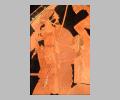
XXDO NOT USE

Side B: arming, right

Interior: detail of warrior at left

Overview: interior

Interior: Achilles and Penthesileia
| Collection: | Munich, Antikensammlungen |
| Summary: | Interior: Achilles and Penthesilea. Sides A-B: arming: youths, with horses. |
| Ware: | Attic Red Figure |
| Painter: | Name vase of the Penthesilea Painter |
| Context: | From Vulci |
| Date: | ca. 470 BC - ca. 460 BC |
| Dimensions: | H. 0.073 m., D. 0.43 m. |
| Primary Citation: | |
| Shape: | Kylix |
| Beazley Number: | 211565 |
| Region: | Etruria |
| Period: | Early Classical |
Decoration Description:
Interior: Achilles killing Penthesilea. The hero plunges his sword into the Amazon's chest, as she falls to the ground. Penthesilea pushes against Achilles' arm and chest, trying to keep him from pushing his sword deeper; she gazes up into his face, as he stares down into hers, but except for Penthesilea's hands, they do not touch one another. Achilles is nude except for his armor: greaves, a helmet, and a mantle draped over his back; he carries a shield and a scabbard over his shoulder. Although the scene is the fight for Troy, Penthesilea is unarmed, wearing only a short chiton with short sleeves, a headband, and jewelry: earrings, bracelets and an ankle bracelet, which accentuate the beauty of the Amazon queen. To the right, bent around the lower right edge of the cup, is a fallen Amazon in Scythian costume, in frontal view with her hands clasped above her head and with her left leg outstretched, her right bent behind her. On the left, a standing warrior wearing a helmet, cuirass, greaves and a mantle and holding a spear and sword. These additional characters force Achilles and Penthesilea into the foreground of the scene. The composition fits the round shape of the cup in a masterly fashion.
Exterior: sides A and B, youths arming, with horses. Youths carrying spears, holding greaves, helmets, and other armor, and attending horses.
Sources Used:
